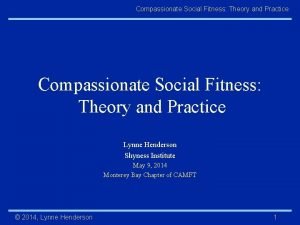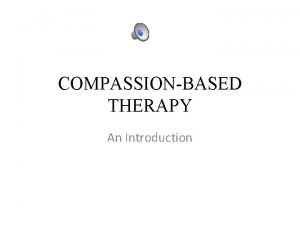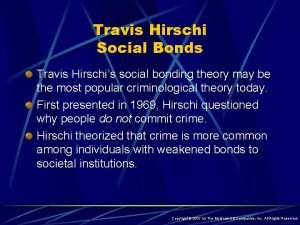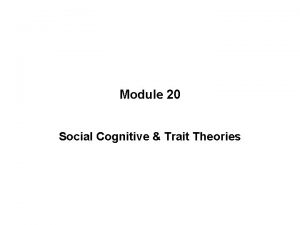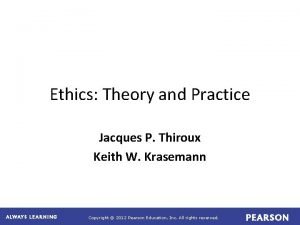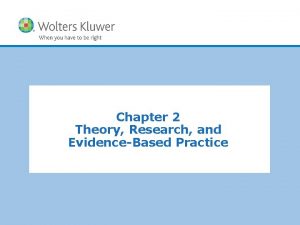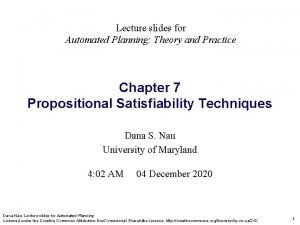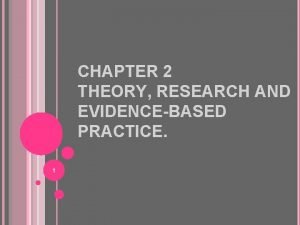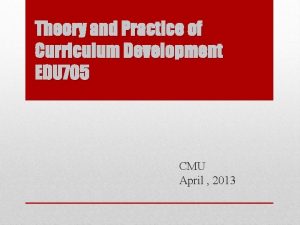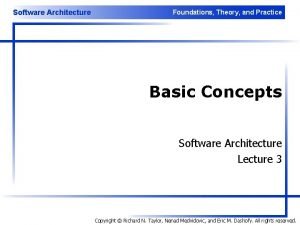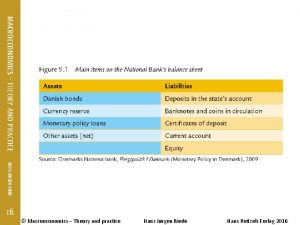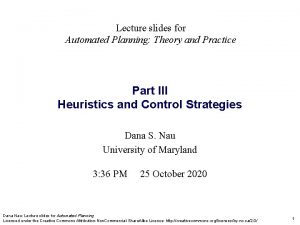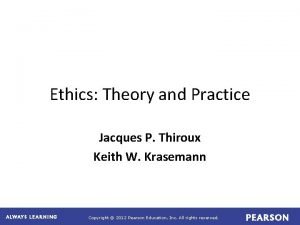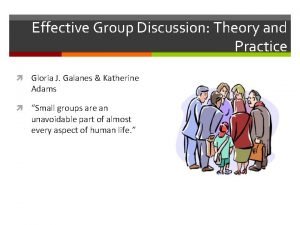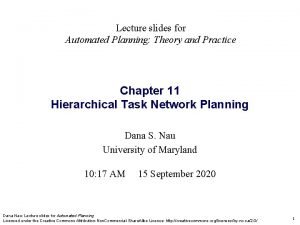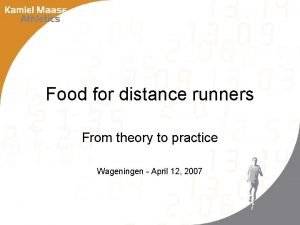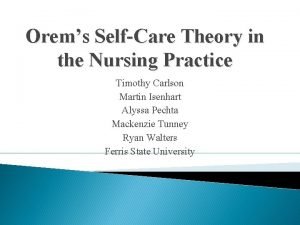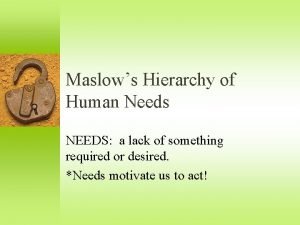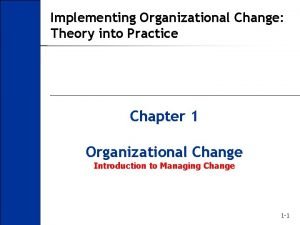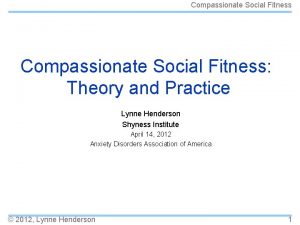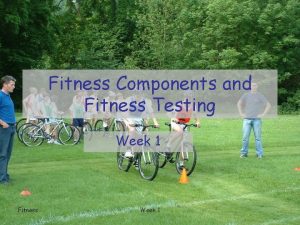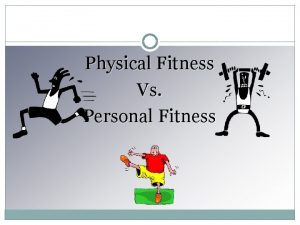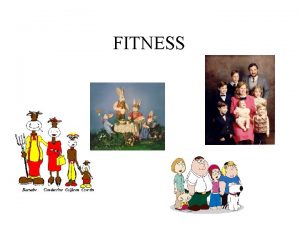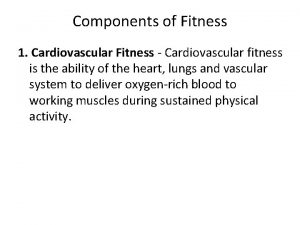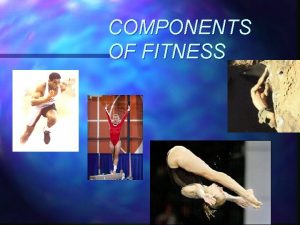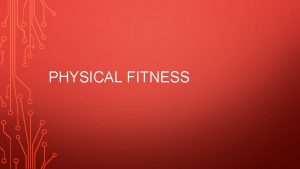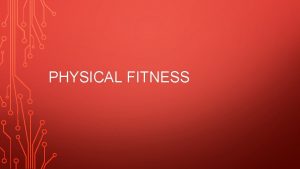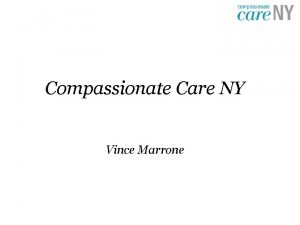Compassionate Social Fitness Theory and Practice Compassionate Social















































































- Slides: 79

Compassionate Social Fitness: Theory and Practice Compassionate Social Fitness: Theory and Practice Lynne Henderson Shyness Institute May 9, 2014 Monterey Bay Chapter of CAMFT © 2014, Lynne Henderson 1

Compassionate Social Fitness: Theory and Practice Overview Social Fitness: Theory and Practice The Model Three Vicious Cycles: Infinite Loops Testing: Shy. Q: shyness questionnaire; EOS: Estimations of Others © 2014, Lynne Henderson 2

Compassionate Social Fitness: Theory and Practice Overview (cont. ) Social Fitness Training CBT (Heimberg & Becker, 2002; Hope & Heimberg, 2010) Changing negative attributions and self beliefs, reducing shame (Henderson & Zimbardo, 2001), beliefs about others and resentment (Henderson, 1998, 2014). Shyness Clinic Research Integrating Compassion Focused Therapy (Gilbert, 2007, 2010, Henderson, 2011) The Threat system, Drive system and Soothing System © 2014, Lynne Henderson 3

Compassionate Social Fitness: Theory and Practice The Experience of Shyness SAD FIXS Self - Blame and Shame Avoidance Distress Fear of Negative Evaluation I Must, but I Can't! X-posure: Fear of both Failure & Success Self - Sabotage © 2014, Lynne Henderson 4

Compassionate Social Fitness: Theory and Practice Perspectives: Integrated Clinical Research Practice design reflect treatment test analyze question measure theory © 2014, Lynne Henderson 5

Compassionate Social Fitness: Theory and Practice Social Fitness Model Addresses needs for emotional connection and agency • Implies: -satisfying interpersonal relationships, -adequate emotion regulation, -an adaptive cognitive style • Implies the proactive pursuit of personal and professional goals. © 2014, Lynne Henderson 6

Compassionate Social Fitness: Theory and Practice Social Fitness Model (cont. ) • Involves frequent social exercise. Many situations for practice and many kinds of behaviors considered adaptive. • As golf, tennis, hiking, and jogging are means to stay physically fit, people join groups and communities, maintain close relationships, meet new people, cultivate friendships, and develop intimacy with a partner to stay socially fit. © 2014, Lynne Henderson 7

Compassionate Social Fitness: Theory and Practice Social Fitness: Cognition and Emotion Adaptive thinking patterns and emotion regulation are important components of social fitness. Shy individuals reverse the self-enhancement bias in social situations, blame themselves and others, and experience shame and resentment. When one is ashamed, others appear contemptuous, when fearful, others look dangerous, when vulnerable, others appear powerful and potentially threatening. Negative emotion and negative thoughts affect each other in an escalating reciprocal pattern. © 2014, Lynne Henderson 8

Compassionate Social Fitness: Theory and Practice Three Vicious Cycles Fight/Flight Shame/self-blame Anger/other-blame fear shame anger negative predictions self-blame other-blame Approach Avoidance Resentment © 2014, Lynne Henderson 9

Compassionate Social Fitness: Theory and Practice Three Compassionate Cycles Face fear Accept self Accept others accept fear support self support others act through emotion self-compassion toward others Acceptance Compassion Forgiveness © 2014, Lynne Henderson 10

Compassionate Social Fitness: Theory and Practice Blaming Others and Empathy: High School Sample � Perspective-taking is associated with adaptive interpersonal functioning. � Empathic concern for others is associated with shyness. � Blaming others is the ONLY significant negative predictor of perspective taking and empathic concern. © 2014, Lynne Henderson 11

Compassionate Social Fitness: Theory and Practice Social Fitness Training Twenty-six Weekly Two-hour Cognitive-Behavioral Group sessions within an interpersonal theory framework Daily Workouts Self-Monitoring, Self-reinforcement Exposures with Cognitive Restructuring Changing negative attributions, beliefs about the self and others Social Skills Training - the second 13 weeks: Reaching out Communication Training - Where do I go from here? Building intimacy - self-disclosure, handling criticism, conflict Expression of Feelings Empathy - listening Attentional Focus Flexibility Training: self- other, empathic response Video Taping, Mirror Wall © 2014, Lynne Henderson 12

Compassionate Social Fitness: Theory and Practice Stanford Students Changed Self-blaming Attributions and Reduced Shame in Eight -week Groups Negative interpersonal outcomes: Internal, stable and global attributions Self-blame and state shame Social anxiety social avoidance and distress trait shame depression © 2014, Lynne Henderson 13

Compassionate Social Fitness: Theory and Practice Results Self-blame © 2014, Lynne Henderson State-shame 14

Compassionate Social Fitness: Theory and Practice Results Internal © 2014, Lynne Henderson Global Stable 15

Compassionate Social Fitness: Theory and Practice Shame and Anger in Shyness: Clinic Sample � Shame predicts self-defeating behavior, passive aggression (MCMI). � Shame is correlated with resentment and antisocial attitudes (MMPI). � Clients with Avoidant Personality Disorder are: more shame-prone, more likely to externalize blame © 2014, Lynne Henderson 16

Compassionate Social Fitness: Theory and Practice Shame And Anger In College Student Sample � Shame and anger in Stanford students SHY students NON-SHY students © 2014, Lynne Henderson 17

Compassionate Social Fitness: Theory and Practice Anger-supporting AT’s about Others (EOS): Students To what extent do you relate to each of these statements? Please make a rating on a 7 point scale from 1 (not at all) to 7 (very much). Shy Non-shy 3. 5 2. 3 People will be rejecting and hurtful if I let them close to me. 3. 3 1. 6 People do not relate to my problems. 4. 6 2. 1 I must not let people know too much about me because they will misuse the information. 3. 5 1. 5 People are more powerful than I am and will take advantage of me. 3. 2 1. 8 If people see my discomfort they will feel contempt for me. 2. 9 1. 7 People will make fun of me and ridicule me. © 2014, Lynne Henderson 18

Compassionate Social Fitness: Theory and Practice Anger-supporting Thoughts and Beliefs Shy Students vs. Clinic Sample �Clinic clients l Shy Students l Significantly Reducing AT’s about Others EOS-Thoughts/Others M = 3. 7; 3. 1 (1 -7) © 2014, Lynne Henderson N 99 t 5. 86 p . 000 19

Compassionate Social Fitness: Theory and Practice Challenging Negative Attributions and Beliefs about Self and Others Choose challenging situation (SUDS 40 - 60) Write it down Imagine the situation does not turn out as well as you hoped Identify at least four Negative Attributions and Beliefs, including both self and other Write them down; Identify Distortions (p. 3 -4) Challenge in Dyads (p. 5); Develop a self-supportive response Notice SUDS reduction and shame reduction © 2014, Lynne Henderson 20

Compassionate Social Fitness: Theory and Practice The “Henderson/Zimbardo” Shyness Questionnaire I blame myself when things do not go the way I want them to. I sometimes feel ashamed after social situations. I am usually aware of my feelings, even if I do not know what prompted them. If someone rejects me I assume that I have done something wrong. I tend to be more critical of other people than I appear to be. © 2014, Lynne Henderson 21

Compassionate Social Fitness: Theory and Practice Shy. Q. (at www. shyness. com) (Rating scale from 1, not at all characteristic of me to 5, extremely characteristic of me) Web site respondents: M=3. 6 (SD=. 6) Stanford students: M=2. 5 (SD=. 6) Clinic Sample: M=3. 6 (SD. 6). Chronbach’s Alpha for six samples=. 92 Correlation with the Revised Cheek and Buss Shyness Scale (college samples) =. 6 and. 7 (Melchior and Cheek, 1990). © 2014, Lynne Henderson 22

Compassionate Social Fitness: Theory and Practice Henderson’s Research: Individualism Gone Awry? Shyness may become a clinical problem because our society currently disavows and rejects sensitivity and cooperative and collaborative vs. dominant or aggressive behavior. Shyness, particularly in males, is negatively stereotyped in the U. S. Shy females are stereotyped as traditional homemakers, not as achievers. When someone is less competitive and more concerned about others’ evaluations, look at their motives and values as well as their behavior. © 2014, Lynne Henderson 23

Compassionate Social Fitness: Theory and Practice Are the Shy Exceptional Leaders? Shy individuals may be our reluctant, socially responsible leaders of the future. Jim Collins (From Good to Great ) studied outstanding CEO’s, called “level five leaders”. They successfully guided companies through times of intense change and challenge. Guess what? They were diffident, shy I do not see many behavioral deficits in the Clinic. When people are accepted for themselves they demonstrate skilled social behavior. © 2014, Lynne Henderson 24

Compassionate Social Fitness: Theory and Practice Shy Leaders: Preliminary Findings Shy leaders: 1. tend to lead from behind and let others take the spotlight. 2. are keen observers of people. 3. listen carefully and are empathic. 4. are motivated, persevering, strategic and genuine. 5. appear passionate about their values and their work. 6. over-prepare for public speaking tasks. 7. push past shyness to get the job done. 8. are collaborative. 9. appear androgynous, with both masculine and feminine traits. © 2014, Lynne Henderson 26

Compassionate Social Fitness: Theory and Practice Vision: A Shy Revolution Clinicians see shyness as a disease, a belief encouraged by drug companies. I see a culture in trouble. We need to focus on and nurture the strengths of those who are shy, starting in childhood in schools and families. We need to focus on their strengths in therapy. We cannot afford to lose their participation in our democracy. America is now known as one of the biggest bullies on the block. Terrorism and torture show us that everyone is vulnerable, and any of us can be bullies. © 2014, Lynne Henderson 27

Compassionate Social Fitness: Theory and Practice Compassion-Focused Therapy Paul Gilbert, Ph. D. The Threat System Gilbert, P. (2009). Introducing compassion-focused therapy. Advances in psychiatric treatment, 15, 199208. doi: 10. 1192/apt. bp. 107. 005264 © 2014, Lynne Henderson 28

Compassionate Social Fitness: Theory and Practice © 2014, Lynne Henderson 29

Compassionate Social Fitness: Theory and Practice How did CFT Start Clinical observation of people struggling with standard therapies Long focus on shame and self-criticism which are known to be linked to poor outcomes Interest in basic evolved systems that regulate a range of psychological processes © 2014, Lynne Henderson 30

Compassionate Social Fitness: Theory and Practice What is helpful Cognitive-Behavioural focused therapies help people distinguish unhelpful thoughts and behaviours - that increase or accentuate negative feelings - and alternative helpful thoughts and behaviours that do the opposite. This approach works well when people experience these alternatives as helpful. However, suppose they say, “I can see the logic and it should feel helpful but I cannot feel reassured by them” or “I know that I am not to blame but still feel to blame”. © 2014, Lynne Henderson 31

Compassionate Social Fitness: Theory and Practice Nature of the problem Able to look at things in different ways – but don’t feel any better Able to generate alternative thoughts – but don’t feel any better Question: What are the mechanisms that help people feel better? © 2014, Lynne Henderson 32

Compassionate Social Fitness: Theory and Practice Basic Philosophy is That: We all just find ourselves here with a brain, emotions and sense of (socially made through evolution) self we did not choose but have to figure out Life involves dealing with tragedies (threats, losses, diseases, decay, death) and people do the best they can Much of what goes on in our minds is not of ‘our design’ and not our fault We are all in the same boat De-pathologising and de-labelling – understanding unique coping processes © 2014, Lynne Henderson 33

Compassionate Social Fitness: Theory and Practice Why Zebras don’t get ulcers! When danger has passed for an animal their threat system switches off. As humans, we can continue to scare ourselves with our imagination, worries and memories which keeps our threat system highly activated after physical danger has passed (Sapolsky, 1994). (Tobyn Bell) © 2014, Lynne Henderson 34

Compassionate Social Fitness: Theory and Practice What if I can’t cope tomorrow? Other animals haven’t evolved the ‘new brain’ areas that result in worrying about what will happen tomorrow or what happened yesterday (Tobyn Bell) © 2014, Lynne Henderson 35

Compassionate Social Fitness: Theory and Practice Types of Affect Regulator Systems Content, safe, connected Drive, excite, vitality Non-wanting/ Affiliative focused Incentive/resourcefocused Safeness-kindness Wanting, pursuing, achieving, consuming Soothing Activating Threat-focused Protection and Safety-seeking Activating/inhibiting Anger, anxiety, disgust © 2014, Lynne Henderson 36

Compassionate Social Fitness: Theory and Practice ‘Brain-storming’ exercise Consider what emotions, physical feelings, motives, behaviours and thoughts are associated with each of these systems THREAT AND PROTECTION DRIVE AND ACHIEVEMENT SOOTHING AND CONNECTION Tobyn Bell © 2014, Lynne Henderson 37

Compassionate Social Fitness: Theory and Practice "When faced with the pain of life, the threat system says, 'This is bad - I need to fight or run away!' The drive system says, 'Things will be better when I have that!' Compassion, intimately related to our safeness system, says, 'Ah, pain. I recognize you. This is how life sometimes is. I will figure out what needs to be done to work with this, and I will bear it in the meantime’’ Russel Kolts © 2014, Lynne Henderson 38

Compassionate Social Fitness: Theory and Practice Humans Have Easily Conditioned Threat System Better safe than sorry: Notice threats quickly Safety Strategies: Fight, flight, freeze, submit or attack Social rank theory: social anxiety & depression When aware of the social rank, status and power of others and when perceive self as inferior Attention: highly sensitive to others’ verbal and non-verbal signals Emotions: uncertainty, social anxiety/depression, anger, resentment Behavior: Appease and avoid © 2014, Lynne Henderson 39

Compassionate Social Fitness: Theory and Practice Threat-focused Protection and Safety-seeking Activating/inhibiting Anxiety Body/feelings Tense Heart increase Dry mouth “Butterflies” Afraid © 2014, Lynne Henderson Attention/Thinking Narrow-focused Danger threat Scan – search Internal vs. external (attribution prediction) Behaviour Passive avoidance Active avoidance Submissive display Dissociate 40

Compassionate Social Fitness: Theory and Practice Threat-focused Protection and Safety-seeking Activating/inhibiting Anger Body/feelings Tense Heart increase Pressure to act Anger © 2014, Lynne Henderson Attention/Thinking Narrow-focused Transgression/block Scan – search Internal vs. external (attribution prediction) Behaviour Increase outputs Aggressive display Approach Dissociate 41

Compassionate Social Fitness: Theory and Practice Menu of Protective/Defensive Emotions Anger – increase effort and signal threat Anxiety – alert to danger and select Disgust – expel/keep away from noxious or undesirable Sadness – acknowledge loss, signal distress Jealousy – threaten and defend Envy – undermine/spoil benefits of the other (Tobyn Bell) © 2014, Lynne Henderson 42

Compassionate Social Fitness: Theory and Practice Automatic threat/protection strategies found in nature Subdue others Frighten others as deterrent Control others Isolate Escape Turn away Hide ‘Play dead’ Cling on to Seek protective others Avoid Camouflage Fit in with the group Comply Submission Hyper-vigilance Predict threat early How do these strategies look in humans? (Tobyn Bell) © 2014, Lynne Henderson 43

Compassionate Social Fitness: Theory and Practice How the threat system organises our mind Attention Consider what might be in each area: e. g. in a threat mind-set where would your attention be? Thinking and reasoning Emotional experience THREAT: ‘I’m in danger!’ Imagery and fantasy Motivation Behaviour © 2014, Lynne Henderson 44

Compassionate Social Fitness: Theory and Practice How the drive system organises our mind Attention Consider what might be in each area: e. g. in a drive mind-set what would your motivation be? Thinking and reasoning Emotional experience DRIVE: ‘I want that!’ Imagery and fantasy Motivation Behaviour © 2014, Lynne Henderson 45

Compassionate Social Fitness: Theory and Practice The Mammalian Importance of Caring Minds Caring as ‘looking after’. Seeking closeness rather than dispersion. Individuals obtain protection, food, and care when ill. Key also is soothing-calming and physiological regulation. Few offspring but high survival rate in comparison to species without attachment, affection and kindness Co-operative and mutual support can develop as we see that our prosperity impacts on that of others, sharing and not-exploiting © 2014, Lynne Henderson 46

Compassionate Social Fitness: Theory and Practice How the soothing system organises our mind Attention Emotional experience SOOTHING: ‘I am valued and connected’ Imagery and fantasy Consider what might be in each area: e. g. in a soothing mind-set what would your emotional experience be? Thinking and reasoning Motivation Behaviour © 2014, Lynne Henderson 47

Compassionate Social Fitness: Theory and Practice Evolved strategies We evolve strategies to cope with our social environment and circumstances. It’s a bit like how animals have evolved over thousands of years. We develop specifically to suit our environment. Evolved strategies often have ‘trade-offs’ and come with unwanted side-effects! (Tobyn Bell) © 2014, Lynne Henderson 48

Compassionate Social Fitness: Theory and Practice Socially Anxious Example Past Experiences: critical mother, distant father, bullied at school, shame based memories Key Fears/Threats: fear of rejection and failure, feeling alone, vulnerable Protective Coping Strategies: appease others, try to be liked, suppress feelings and needs, criticize self Unintended/Unwanted Consequences: Own needs ignored, feel put upon, angry, not achieve personal goals, lose sense of self, feel fragile (adapted from Tobyn Bell) © 2014, Lynne Henderson 49

Compassionate Social Fitness: Theory and Practice External and internal threats For example, a person attending a social event might fear: • being rejected by the people there (external threat) • also worry about being overwhelmed with anxiety (internal threat). Such threats often interact: e. g. the same person might fear their anxiety will become so overwhelming that other people will notice and criticise them (external threat). The protection strategies for internal and external threats can be different. Coping might include: • being non-assertive and people pleasing (external) • using alcohol to reduce anxiety (internal). (adapted from Tobyn Bell) © 2014, Lynne Henderson 51

Compassionate Social Fitness: Theory and Practice Self-monitoring and self-blame as protection Self-monitoring and self-blame can be used to appease someone we see as more powerful than us, as a means to stay safe and out of harm. If, for example, a bully or a parent’s behaviour is frightening and unpredictable we might try and tip-toe around them like they are a sleeping tiger. When we do arouse their negative attention we might be cross at ourselves for increasing our vulnerability or the risk of attack. If we cannot control or influence the behaviours of important others, we might begin to keep a tight watch over our own actions and emotions, blaming ourselves severely for mistakes. Blaming the other person might be too scary or dangerous, especially for a child. (Tobyn Bell) © 2014, Lynne Henderson 52

Compassionate Social Fitness: Theory and Practice COPING STRATEGY Examples INTENDED POSSIBLE UNINTENDED CONSEQUENCES OR DRAWBACKS Always putting on a brave face Be as others want Withdrawing from other people Avoid situations where I can ‘fail’ Drinking alcohol to cope Trying to be perfect Analysing and going over my mistakes Preparing for the worst/ worrying © 2014, Lynne Henderson 53

Compassionate Social Fitness: Theory and Practice CHAIR EXERCISE Write down some recent examples of your own self-criticism. Try and remember a situation when you gave yourself a hard time: what did you say or feel towards yourself? Read these criticisms out loud to an empty chair, imagining someone else is sitting there. How you think a person in the chair might feel or respond? © 2014, Lynne Henderson 54

Compassionate Social Fitness: Theory and Practice COMPASSIONATE SELFCORRECTION -Focuses on the desire to improve -Focuses on growth and enhancement -Is forward-looking -Is given with encouragement support and kindness -Builds on positives (e. g. seeing what one did well and then considering learning points) -Focuses on attributes and specific qualities of self -Focuses on and hopes for success -Increases chances of engaging FOR MISTAKES -Guilt, engage with feelings -Sorrow, remorse -Reparation Example: the encouraging/supportive teacher with the child who is struggling © 2014, Lynne Henderson SHAME BASED SELFATTACKING -Focuses on the desire to condemn and punish -Focuses on punishing past errors -Is often backward looking -Is given with anger, frustration, contempt, disappointment -Focuses on deficits and fear of exposure -Focuses on a blaming whole self -Focuses on high fear of failure -Increases chances of avoidance and withdrawal FOR MISTAKES -Shame, avoidance, fear -Heart-sink, lowered mood -Aggression Example: the critical teacher with the child who is struggling 55

Compassionate Social Fitness: Theory and Practice Compassionate Mind-Self WISDOM SKILLS -TRAINING WISDOM Imagery ATTRIBUTES Attention Sympathy Sensitivity STRENGTH Care for well-being Feeling Reasoning Compassion Non. Judgement STRENGTH Distress tolerance Empathy Behaviour Sensory COMMITMENT © 2014, Lynne Henderson COMMITMENT 56

Compassionate Social Fitness: Theory and Practice Key Imagery Tasks Soothing breathing rhythm Safe ‘welcoming’ place Compassion colour Compassionate self Compassionate other/image Building and strengthening the compassionate mind as building capacity to think and feel compassionately © 2014, Lynne Henderson 57

Compassionate Social Fitness: Theory and Practice Why imagery? Imagery has been shown to be more emotionally powerful than verbal expressions VERBAL: Chocolate Cake or IMAGINAL: Tobyn Bell © 2014, Lynne Henderson 58

Compassionate Social Fitness: Theory and Practice Imagery Exercise: Desire to be at peace May I be happy, may I be well, may I be at peace Exercise: Using memory Remember a time someone was kind, caring, and warm toward you Remember a time you were kind, caring, and warm toward someone in distress Exercise: Desire that others be at peace May you be happy, may you be well, may you be at peace Soothing breathing rhythm: © 2014, Lynne Henderson 59

Compassionate Social Fitness: Theory and Practice Your Safe Place Safe ‘welcoming’ place Lower or close the eyes Find your soothing rhythm breathing Imagine a place that gives you feelings of safeness, calm and contentment, perhaps a quiet room, a beach, or in the woods Focus on the details and use all five senses: what you see, touch, hear, smell, taste Your safe place welcomes you and enjoys having you there. It is your own, you belong there and can rest. Feel the safeness and connection; feel its welcome. When ready, opening the eyes © 2014, Lynne Henderson 60

Compassionate Social Fitness: Theory and Practice Developing Compassion Images Ideal caring and compassionate self and/or other --- define ideal as everything you would want, need • Wisdom a sentient mind who understands the struggles of humanity and self. Empathic stance, self-transcendent • Strength as ‘calm authority’ fortitude, endurance, complete benevolence • Caring as a genuine desire for one’s well-being – Commitment and motivation • Include compassionate attributes © 2014, Lynne Henderson 61

Compassionate Social Fitness: Theory and Practice Compassionate Mind-Self WISDOM SKILLS -TRAINING WISDOM Imagery ATTRIBUTES Attention Sympathy Sensitivity STRENGTH Care for well-being Feeling Reasoning Compassion Non. Judgement STRENGTH Distress tolerance Empathy Behaviour Sensory COMMITMENT © 2014, Lynne Henderson COMMITMENT 62

Compassionate Social Fitness: Theory and Practice Imagery Non-verbal Communication • Compassionate facial expression – smile • Compassionate voice – tone, form and pace • Compassionate posture (e. g. can change depending on the actions) • Sense of appearance, and colour (e. g. clothes) • Method Acting for compassionate self Sensory qualities help form image © 2014, Lynne Henderson 63

Compassionate Social Fitness: Theory and Practice Imagining the Compassionate Other/Self Explain point of Compassionate-other/self imagery work Inner helper, inner guide, access to self-soothing system through relating to self or other (no different in principle to activating any other system e. g. sexual – these systems were designed for social interactions – social mentality theory (Gilbert, 2000; Fonagy & Target, 2006)) Now for a moment, focus on your breathing and try to feel soothing rhythm. Look down or close your eyes and imagine your image of your compassionate ideal ‘other’ caring for you. Useful specific questions: would they be old or young, male or female, colour of their eyes, tall or short – more than one © 2014, Lynne Henderson 64

Compassionate Social Fitness: Theory and Practice Threat Processing Threat processing cannot be understood in single domains of cognitive, behavioural, physiological but are complex multi-modal brain states Threat processing (often) cannot be focused on single emotions, e. g. anxiety but combination and conflicts of emotions Threat emotions can have conscious and nonconscious attributes Need to work in multimodal domains © 2014, Lynne Henderson 67

Compassionate Social Fitness: Theory and Practice Threat relations Conflicts of Emotions blocks Anger blo ck s Anxiety Sadness ks c blo Each emotion can have a variety of defensive behaviours and memories © 2014, Lynne Henderson 68

Compassionate Social Fitness: Theory and Practice Emotions Fusion Emotions that we experience together can ‘wire’ together –basic conditioning model A child is hit ( fear) then sent to their room (loneliness-no rescue). Fear and loneliness become fused. Therapists sometimes miss the importance of loneliness as a core emotion to work with while engaging with fear. Anger and fear also a common fusion -Emotional Schemas (Robert Leahy) © 2014, Lynne Henderson 69

Compassionate Social Fitness: Theory and Practice Threat Emotions and Conflicts Threat – boss criticises your work Rapid access of threat-safety strategies Angry-attack revenge Anxious - flee submit Cry want to seek reassurance Threat to self-identity and self as social agent in social role Problems can occur when different emotions arise at similar time, or when one emotion triggers another – can leave us feeling confused: ‘I don’t know what I feel‘ Take time to explain that to clients about emotional conflicts – ‘tricky brains’ © 2014, Lynne Henderson 71

Compassionate Social Fitness: Theory and Practice Exercise Imagine an argument with someone you care for: Now focus on different voices and parts What does your: angry part think, feel and want to do? anxious part think, feel and want to do? sad part think, feel and want to do? Do they turn up at different times and conflict? Build the compassion self © 2014, Lynne Henderson 72

Compassionate Social Fitness: Theory and Practice Multi-Mind and Multiple Patterns Thoughts Body Actions Memories ARGUMENT Thoughts Body Actions Memories Link © 2014, Lynne Henderson to fears and memories 73

Compassionate Social Fitness: Theory and Practice Multi-Mind and Multiple Patterns ANGRY Blame them They shouldn’t have done that Get my own back ANXIOUS What if it is partly me? They might not like me now Appease ARGUMENT SADNESS Damaged the relationship Loss Withdraw © 2014, Lynne Henderson COMPASSION Mindfulness and stand back Mentalize and validate What would be helpful Kind voice - stillness 74

Compassionate Social Fitness: Theory and Practice Process of Multi Self All our minds have these parts – helpful to get to know them better – Aiding emotions discrimination and awareness of conflicts of emotions as ‘normal’ and common. © 2014, Lynne Henderson 75

Compassionate Social Fitness: Theory and Practice Compassion for the threat Systems © 2014, Lynne Henderson 76

Compassionate Social Fitness: Theory and Practice Fears of Compassion Remember: Compassion focused therapy targets the activation of the soothing system (to gain positive affect) to connect thoughts with the emotional experience referred to by those thoughts. Compassion can be threatening. Clients can be afraid of compassion toward the self, from others and for others. Gilbert, P. , Mc. Ewen, K. , Matos, M. , & Rivis, A. (2011). Fears of compassion: Development of three self-report measures. Psychology and Psychotherapy: Theory, Research and Practice 84, 239 -255. © 2014, Lynne Henderson 77

Compassionate Social Fitness: Theory and Practice Compassion Focus Empathy and sympathy for one’s own distress Awareness with out-judgement or blame Refocus/activate safe-conferring processing systems Compassionate attention, thinking, behaviour Generate compassionate feeling (warmth) Use images and sensory experiences Key focus is “finding what is experienced as helpful, kind and supportive in this moment” © 2014, Lynne Henderson 83

Compassionate Social Fitness: Theory and Practice Compassionate Mind - Alleviation SKILLS -TRAINING Warmth Imagery Attention ATTRIBUTES Sympathy Sensitivity Care for well-being Feeling Warmth © 2014, Lynne Henderson Compassion Non-Judgement Sensory Warmth Reasoning Distress tolerance Empathy Behaviour Warmth 84

Compassionate Social Fitness: Theory and Practice Three Compassionate Cycles Face fear Accept self Accept others Accept fear Support self Support others Act through emotion Self-compassion Compassion toward others Acceptance Compassion Forgiveness © 2014, Lynne Henderson 85

Compassionate Social Fitness: Theory and Practice Some Useful Websites www. compassionatemind. co. uk www. compassionatewellbeing. com www. mindfulcompassion. com www. self-compassion. org www. ccare. stanford. edu www. mindfulselfcompassion. org www. mindandlife. org © 2014, Lynne Henderson 86

Compassionate Social Fitness: Theory and Practice Further reading John Cacioppo & William Patrick – Loneliness: Human nature and the need for social connection Chris Germer- The mindful path to self-compassion Paul Gilbert- The compassionate mind Paul Gilbert & Choden – Mindful Compassion Lynne Henderson-The compassionate mind guide to building social confidence Lynne Henderson – Helping your shy and socially anxious client: A Social Fitness Training protocol using CBT Russell Kolts- Managing your anger using compassion focused therapy Deborah Lee- Recovering from trauma using compassion focused therapy Kristen Neff- Self compassion Mary Welford- Building your self-confidence using compassion focused therapy © 2014, Lynne Henderson 87

Compassionate Social Fitness: Theory and Practice Remember……. The future depends on what we do in the present. Mahatma Gandhi Try not to become a man of success but a man of value. Albert Einstein © 2014, Lynne Henderson 88

Compassionate Social Fitness: Theory and Practice Thank you Contact information: Lynne Henderson, Ph. D. Director, Shyness Institute Director, Social Fitness Training, Courageous Leadership, LLC Author: Building Social Confidence using Compassion Focused Therapy and Helping your shy and socially anxious client: A Social Fitness Training protocol using CBT lhenderson@rivcons. com clinic@shyness. com www. thecourage 2 lead. com © 2014, Lynne Henderson 89
 Health and fitness: theory and practice
Health and fitness: theory and practice What is skill-related fitness? *
What is skill-related fitness? * Compassionate respectful and caring
Compassionate respectful and caring Compassionate consideration uoa
Compassionate consideration uoa Example of compassionate letter to yourself
Example of compassionate letter to yourself Compassionate ottawa
Compassionate ottawa Allahumma a'izzal islam wal muslimin
Allahumma a'izzal islam wal muslimin In the name of allah the compassionate the merciful
In the name of allah the compassionate the merciful Allah the compassionate
Allah the compassionate The most compassionate
The most compassionate Compassionate capitalism definition
Compassionate capitalism definition Pallatie
Pallatie Practice assessor and practice supervisor
Practice assessor and practice supervisor Social bond theory travis hirschi
Social bond theory travis hirschi Software testing and quality assurance theory and practice
Software testing and quality assurance theory and practice Quality revolution in software testing
Quality revolution in software testing Theory of goodenough and gerhart
Theory of goodenough and gerhart Software testing and quality assurance theory and practice
Software testing and quality assurance theory and practice Software testing and quality assurance theory and practice
Software testing and quality assurance theory and practice Trait theory vs social cognitive theory
Trait theory vs social cognitive theory Theory and practice of histotechnology
Theory and practice of histotechnology Oligarchical collectivism meaning
Oligarchical collectivism meaning Leadership theory and practice 6th edition
Leadership theory and practice 6th edition Jacques p thiroux
Jacques p thiroux Theory research and evidence based practice
Theory research and evidence based practice Dan c. marinescu
Dan c. marinescu Accounting theory and practice notes
Accounting theory and practice notes Coaching theory and practice
Coaching theory and practice The theory and practice of oligarchical collectivism
The theory and practice of oligarchical collectivism Automated planning theory and practice
Automated planning theory and practice Teaching practice chapter 1
Teaching practice chapter 1 What is text linguistics
What is text linguistics Alon global marketing download
Alon global marketing download Theory research and evidence-based practice
Theory research and evidence-based practice Daniel tanner 1980 definition of curriculum explanation
Daniel tanner 1980 definition of curriculum explanation Software architecture foundations theory and practice
Software architecture foundations theory and practice Macroeconomics theory and practice
Macroeconomics theory and practice Automated planning theory and practice
Automated planning theory and practice Authentic leadership theory and practice
Authentic leadership theory and practice Software architecture foundations theory and practice
Software architecture foundations theory and practice Global marketing contemporary theory practice and cases
Global marketing contemporary theory practice and cases Ipre
Ipre Substance abuse counseling theory and practice
Substance abuse counseling theory and practice Batch sequential architecture
Batch sequential architecture Charles babbage theory of management
Charles babbage theory of management Learning approaches theory and practice
Learning approaches theory and practice Servant theories
Servant theories Global marketing: contemporary theory, practice, and cases
Global marketing: contemporary theory, practice, and cases Global marketing contemporary theory practice and cases
Global marketing contemporary theory practice and cases Effective group discussion defines human communication as
Effective group discussion defines human communication as English lexicology theory and practice
English lexicology theory and practice Automated planning theory and practice
Automated planning theory and practice Global marketing contemporary theory practice and cases
Global marketing contemporary theory practice and cases Carbo-loaders meal
Carbo-loaders meal Product line architecture
Product line architecture Apa itu social thinking
Apa itu social thinking Social thinking social influence social relations
Social thinking social influence social relations Margaret newman background
Margaret newman background X bar theory
X bar theory Set theory practice
Set theory practice Theory of unpleasant symptoms
Theory of unpleasant symptoms Applying educational theory in practice
Applying educational theory in practice Virginia henderson 14 needs
Virginia henderson 14 needs The theory of consumer choice chapter 21 practice
The theory of consumer choice chapter 21 practice Dorothea orem metaparadigm
Dorothea orem metaparadigm Maslow theory in nursing practice
Maslow theory in nursing practice Jean watson theory of caring diagram
Jean watson theory of caring diagram Implementing organizational change theory into practice
Implementing organizational change theory into practice Trait approaches to leadership
Trait approaches to leadership Continental drift vs plate tectonics theory
Continental drift vs plate tectonics theory Continental drift vs plate tectonics
Continental drift vs plate tectonics Difference between classical theory and neoclassical theory
Difference between classical theory and neoclassical theory Motivation in group formation
Motivation in group formation Semantic satiation
Semantic satiation Plate theory and rate theory
Plate theory and rate theory Title theory and lien theory
Title theory and lien theory X and y theory
X and y theory Game theory and graph theory
Game theory and graph theory Vbt and mot difference
Vbt and mot difference Dxz and dxz overlap
Dxz and dxz overlap
